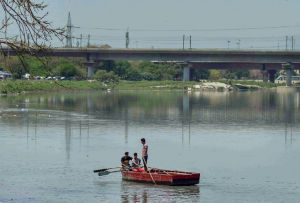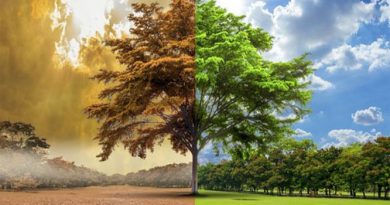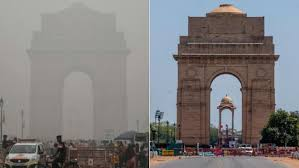Environment is getting pollution free due to lockdown: The world should take serious note of this on Earth Day

The effects of lock down have been positive on the environment.
What we have done about the environment of the Earth in the blind race for development has been a matter of concern for the last nearly four decades but developed countries continue to use it to dominate the developing countries instead of doing their responsibility and developing countries have also joineddeveloped countries in the race for development in their the campaign to destroy the environment by following the path of the developed countries.
The situation remained the same even after 28 years of the Earth Conference, but the lock-down in the world horrified by the Corona epidemic has allowed the environment to recover. The poison of the air has waned and the water of the rivers has been purified. The Ganga, which had been running for 45 years in India and was seen to be a modest success even after spending about 20 thousand crores in the last five years, was cleared by the three-week lock-down. Not only this, the Himalayan peaks of Himachal Pradesh started to be seen from Chandigarh. The rate of industrial income has definitely fallen from 7 and a half percent to two percent. The economy is in danger. But this is the time when the whole world is thinking on the balance of environment and development as seriously as dealing with the Corona crisis.
The landscape of such a changed environment, the lines of vehicles on the road, smoke-blowing factories and dust-strewn constructions had become the hallmark of the development of our cities. We all know how poisonous the air of our cities and how polluted the rivers are. Now see the improvement that has been made in this lock down. According to the latest data from the Central Pollution Control Board, New Delhi, good signs of environmental improvement were also seen during the Janata curfew on 22 March. The air quality index (AQI) on that day in Delhi was between 101 and 250. Compared to the figures of the same day six years ago, the relatively larger polluting dust particles of the air The volume of 10 was found to be 44%. Micro-air particles considered more dangerous Although a decrease of 2.5% was noted, the reason for this could be attributed to the time it takes to settle down on a surface.
The surprisingly curtailed gases of nitrogen and sulfur oxides marked a 34 and 51 percent reduction in some areas of Delhi compared to March 21, as motor vehicles stopped on roads. Although the numbers of Noida and Ghaziabad were found to be as good as the national capital regions, the air pollution in Gurgaon and Faridabad was not found to improve so the role of local causes in air pollution cannot be ignored.

The effect of lock down, Yamuna became clear – Photo: PTI
In the world bound by the rules of the global economy, when the dominance of economists and business managers began to increase, then more and more production and consumption were pushed beyond the concepts of ancient civilizations like India to give equal respect to nature and its various components as mother. Began to be considered an index of prosperity. In just over three decades, climate change disasters, global heat problems and pollution-related diseases have brought the discussion of environmental protection and ecological balance to the center of debate in many global and national forums. Recognizing the importance of environmental protection, many countries of the world have started incorporating seventeen sustainable development goals in their development plans.
Data for the first week of lockdown suggest significant improvements in air quality. Air quality is calculated as an air quality index based on the amount of major air pollutants involved. The air quality is considered to be good when the AQI level is fifty to fifty. Thirty-one to one hundred AQI air satisfactory, one hundred one to two hundred medium level bad, two hundred one to three hundred spoiled, three hundred one to four hundred extremely poor and four hundred to five hundred AQI air Is considered dangerous.
According to data from the Central Pollution Control Board, this year, air quality was good (out of 30) and satisfactory (61 in total 91 cities in India) as compared to good and satisfactory air quality index of 54 cities on 21 March and poor air quality index in 9 cities. ) Was found. On this day, the air of any city was not found to be bad, but in many cities like Kanpur, Lucknow, Muzaffarnagar, Kalyan, Singrauli, Guwahati, as of March 25-28, the level of PM 2.5 was definitely poor due to local reasons. In the first week of the lockdown between 25 March and 1 April this year in Delhi, P.M. 2.5 measured cubic meters at just 16–42 micrograms, which is significantly lower than the cubic at 72–187 in 2019, 72 to 171 in 2018 and 49 to 116 micrograms in 2016.
Based on the photographs and media reports being made from the spot, it can be said that due to this lockdown, the pollution level of Ganga in Yamuna and Kanpur in Delhi and Varanasi has also improved significantly. Many continuously polluted drains have been closed last year in the implementation of Namami Gange project. Data from the Uttar Pradesh Pollution Control Board show that during this period, the amount of soluble oxygen in the Ganges in Varanasi was found to be 8.3 -8.9 grams per liter, which is more than the minimum level of clean water at 7 grams per liter. Delhi Jal Board and citizens believe that the pollution level of Yamuna has also improved in a substantial amount in this lockdown.
If the data of the current lock down for the entire period is revealed, then they will definitely be revolutionary in terms of environment. The lockdown period may increase further. But there is a very serious time on the balance of environment and development for the world, will India lead it?
Disclaimer: This is the author’s personal views. Newsline time is not responsible for the accuracy and completeness of the information and facts included in the article. Send us your thoughts on www.newslinetime.com Attach a short introduction and photo to the article as well.





